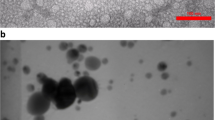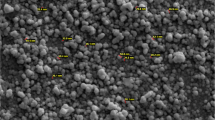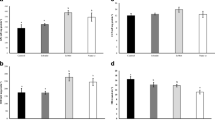Abstract
The present study aimed to examine individual nutritional and ameliorative effects of silica nanoparticles (SiO2NPs) and natural zeolite nanoparticles (ZeNPs) and their potential role as carriers to alter the bioavailability of curcumin. Common carps (Cyprinus carpio) were fed during 60 days with a control diet, and curcumin, turmeric, SiO2NPs, curcumin-loaded SiO2NPs, ZeNPs, and curcumin-loaded ZeNPs each at 1, 50, 6.15, 7.15, 39, and 40 g/kg diet, respectively. The highest weight gain (WG) and specific growth rate (SGR) were observed in fish fed with turmeric (P < 0.05). Moreover, dietary curcumin and ZeNPs increased the content of monounsaturated fatty acids (P < 0.05). After exposure to silver nanoparticles (AgNPs), the lowest amount of aspartate aminotransferase (AST) was obtained in fish fed with curcumin (P < 0.05). In addition, alanine aminotransferase (ALT) decreased significantly in the negative control, curcumin, and curcumin-loaded SiO2NPs treatments in comparison to the positive control group (P < 0.05). The lowest silver accumulation was observed in the negative control and SiO2NPs groups (P < 0.05). This experiment demonstrated that while the nanoencapsulation of curcumin on SiO2NPs and ZeNPs did not enhanced the impact of curcumin on the growth and biochemical factors of carps, it can still be considered a potential dietary supplement for enhancing growth and antioxidant indices when added individually to the diet.
Graphical abstract








Similar content being viewed by others
Data availability
All data and materials are included in this published article.
References
Abdel-Latif HM, Abdel-Tawwab M, Khafaga AF, Dawood MA (2020) Dietary oregano essential oil improved the growth performance via enhancing the intestinal morphometry and hepato-renal functions of common carp (Cyprinus carpio L.) fingerlings. Aquaculture 526:735432
Abdelrazek HMA, Tag HM, Kilany OE, Reddy PG, Hassan AM (2017) Immuomodulatory effect of dietary turmeric supplementation on Nile tilapia (Oreochromis niloticus). Aquacult Nutr 23:1048–1054
Abdel-Tawwab M, Abbass FE (2017) Turmeric powder, Curcuma longa L., in common carp, Cyprinus carpio L., diets: growth performance, innate immunity, and challenge against pathogenic Aeromonas hydrophila infection. J W Aquacult Soc 48:303–312
Akdemir F, Orhan C, Tuzcu M, Sahin N, Juturu V, Sahin K (2017) The efficacy of dietary curcumin on growth performance, lipid peroxidation and hepatic transcription factors in rainbow trout Oncorhynchus mykiss (Walbaum) reared under different stocking densities. Aquacult Res 48:4012–4021
Akhter F, Rao AA, Abbasi MN, Wahocho SA, Mallah MA, Anees-ur-Rehman H, Chandio ZA (2022) A comprehensive review of synthesis, applications and future prospects for silica nanoparticles (SNPs). Silicon:1–16
Alagawany M, Farag MR, Abdelnour SA, Dawood MA, Elnesr SS, Dhama K (2021) Curcumin and its different forms: a review on fish nutrition. Aquaculture 532:736030
Alinezhad S, Faridi M, Falahatkar B, Nabizadeh R, Davoodi D (2017) Effects of nanostructured zeolite and aflatoxin B1 in growth performance, immune parameters and pathological conditions of rainbow trout Oncorhynchus mykiss. Fish Shellfish Immunol 70:648–655
Ansari MA, Shukla AK, Oves M, Khan HM (2016) Electron microscopic ultrastructural study on the toxicological effects of AgNPs on the liver, kidney and spleen tissues of albino mice. Environ Toxicol Pharmacol 44:30–43
AOAC (1990) Official methods of analysis. AOAC, Washington DC
AshaRani P, Low Kah Mun G, Hande MP, Valiyaveettil S (2009) Cytotoxicity and genotoxicity of silver nanoparticles in human cells. ACS Nano 3:279–290
Ashouri S, Keyvanshokooh S, Salati AP, Johari SA, Pasha-Zanoosi H (2015) Effects of different levels of dietary selenium nanoparticles on growth performance, muscle composition, blood biochemical profiles and antioxidant status of common carp (Cyprinus carpio). Aquaculture 446:25–29
Babaei M, Behzadi Tayemeh M, Jo MS, Yu IJ, Johari SA (2022) Trophic transfer and toxicity of silver nanoparticles along a phytoplankton-zooplankton-fish food chain. Sci Total Environ 842:156807. https://doi.org/10.1016/j.scitotenv.2022.156807
Bao X, Chen M, Yue Y, Liu H, Yang Y, Yu H, Yu Y, Duan N (2022) Effects of dietary nano-curcumin supplementation on growth performance, glucose metabolism and endoplasmic reticulum stress of juvenile largemouth bass, Micropterus salmoides. Front Mar Sci 9:924569
Cao L, Ding W, Du J, Jia R, Liu Y, Zhao C, Shen Y, Yin G (2015) Effects of curcumin on antioxidative activities and cytokine production in Jian carp (Cyprinus carpio var. Jian) with CCl4-induced liver damage. Fish Shellfish Immunol 43:150–157
Choudhury SR, Ordaz J, Lo C-L, Damayanti NP, Zhou F, Irudayaraj J (2017) From the cover: zinc oxide nanoparticles-induced reactive oxygen species promotes multimodal cyto-and epigenetic toxicity. Toxicol Sci 156:261–274
Dalle Zotte A (2002) Perception of rabbit meat quality and major factors influencing the rabbit carcass and meat quality. Livestock Prod Sci 75:11–32
Danabas D (2011) Fatty acids profiles of rainbow trout (Oncorhynchus mykiss Walbaum, 1792), fed with zeolite (Clinoptilolite). J Animal Plant Sci 21:561–565
Eya JC, Parsons A, Haile I, Jagidi P (2008) Effects of dietary zeolites (bentonite and mordenite) on the performance juvenile rainbow trout Onchorhynchus myskis. Aust J Basic Appl Sci 2:961–967
Gangwar RK, Tomar GB, Dhumale VA, Zinjarde S, Sharma RB, Datar S (2013) Curcumin conjugated silica nanoparticles for improving bioavailability and its anticancer applications. J Agri Food Chem 61:9632–9637
Hamidian G, Zirak K, Sheikhzadeh N, Khani Oushani A, Shabanzadeh S, Divband B (2018) Intestinal histology and stereology in rainbow trout (Oncorhynchus mykiss) administrated with nanochitosan/zeolite and chitosan/zeolite composites. Aquacult Res 49:1803–1815
Ismael NE, El-hameed A, Samah A, Salama AM, Naiel MA, Abdel-Latif HM (2021) The effects of dietary clinoptilolite and chitosan nanoparticles on growth, body composition, haemato-biochemical parameters, immune responses, and antioxidative status of Nile tilapia exposed to imidacloprid. Environ Sci Pollut Res 28:29535–29550
Jambhrunkar S, Karmakar S, Popat A, Yu M, Yu C (2014) Mesoporous silica nanoparticles enhance the cytotoxicity of Curcumin. RSC Adv 4:709–712
Kanyılmaz M, Tekelioğlu N, Sevgili H, Uysal R, Aksoy A (2015) Effects of dietary zeolite (clinoptilolite) levels on growth performance, feed utilization and waste excretions by gilthead sea bream juveniles (Sparus aurata). Animal Feed Sci Technol 200:66–75
Khan MS, Qureshi NA, Jabeen F, Asghar MS, Shakeel M, Fakhar-e-Alam M (2017) Eco-friendly synthesis of silver nanoparticles through economical methods and assessment of toxicity through oxidative stress analysis in the Labeo rohita. Biol Trace Element Res 176:416–428
Kotcherlakota R, Barui AK, Prashar S, Fajardo M, Briones D, Rodríguez-Diéguez A, Patra CR, Gómez-Ruiz S (2016) Curcumin loaded mesoporous silica: an effective drug delivery system for cancer treatment. Biomater Sci 4:448–459
Levard C, Hotze EM, Lowry GV, Brown GE Jr (2012) Environmental transformations of silver nanoparticles: impact on stability and toxicity. Environ Sci Technol 46:6900–6914
Li M, Xin M, Guo C, Lin G, Wu X (2017) New nanomicelle curcumin formulation for ocular delivery: improved stability, solubility, and ocular anti-inflammatory treatment. Drug Dev Ind Pharm 43:1846–1857
Liu HP, Wen B, Chen ZZ, Gao JZ, Liu Y, Zhang YC, Wang ZX, Peng Y (2019) Effects of dietary vitamin C and vitamin E on the growth, antioxidant defence and digestive enzyme activities of juvenile discus fish (Symphysodon haraldi). AquacultNutr 25:176–183
Mahboub HH, Shahin K, Mahmoud SM, Altohamy DE, Husseiny WA, Mansour DA, Shalaby SI, Gaballa MM, Shaalan M, Alkafafy M (2022) Silica nanoparticles are novel aqueous additive mitigating heavy metals toxicity and improving the health of African catfish Clarias gariepinus. Aquat Toxicol 249:106238
Mahmoud HK, Al-Sagheer AA, Reda FM, Mahgoub SA, Ayyat MS (2017) Dietary curcumin supplement influence on growth, immunity, antioxidant status, and resistance to Aeromonas hydrophila in Oreochromis niloticus. Aquaculture 475:16–23
Ming J, Ye J, Zhang Y, Xu Q, Yang X, Shao X, Qiang J, Xu P (2020) Optimal dietary curcumin improved growth performance, and modulated innate immunity, antioxidant capacity and related genes expression of NF-κB and Nrf2 signaling pathways in grass carp (Ctenopharyngodon idella) after infection with Aeromonas hydrophila. Fish Shellfish Immunol 97:540–553
Moghadam H, Sourinejad I, Johari SA (2021) Growth performance, haemato-immunological responses and antioxidant status of Pacific white shrimp Penaeus vannamei fed with turmeric powder, curcumin and curcumin nanomicelles. Aquacult Nutr 27:2294–2306
Moniruzzaman M, Min T (2020) Curcumin, curcumin nanoparticles and curcumin nanospheres: a review on their pharmacodynamics based on monogastric farm animal, poultry and fish nutrition. Pharmaceutics 12:447
Nakano T, Kanmuri T, Sato M, Takeuchi M (1999) Effect of astaxanthin rich red yeast (Phaffia rhodozyma) on oxidative stress in rainbow trout. Biochim et Biophys Acta (BBA)-Gen Subj 1426:119–125
Nakano N, Shirasaka N, Koyama H, Hino M, Murakami T, Shimizu S, Yoshizumi H (2000) C19 odd-chain polyunsaturated fatty acids (PUFAs) are metabolized to C21-PUFAs in a rat liver cell line, and curcumin, gallic acid, and their related compounds inhibit their desaturation. Biosci, Biotechnol Biochem 64:1641–1650
Nickum JG, Bart HL Jr, Bowser PR, Greer IE, Hubbs C, Jenkins JA, MacMillan JR, Rachlin JW, Rose JD, Sorensen PW, Tomasso JR (2004) Guidelines for the use of fishes in research. American Fisheries Society, Bethesda, Maryland, p 54
Petushkov A, Ndiege N, Salem AK, Larsen SC (2010) Toxicity of silica nanomaterials: zeolites, mesoporous silica, and amorphous silica nanoparticles. Adv Mol Toxicol 4:223–266
Pirani F, Moradi S, Ashouri S, Johari SA, Ghaderi E, Kim HP, Yu IJ (2021) Dietary supplementation with curcumin nanomicelles, curcumin, and turmeric affects growth performance and silver nanoparticle toxicity in Cyprinus carpio. Environ Sci Pollut Res 28:64706–64718
Sahu S, Das BK, Mishra BK, Pradhan J, Samal SK, Sarangi N (2008) Effect of dietary Curcuma longa on enzymatic and immunological profiles of rohu, Labeo rohita (Ham.), infected with Aeromonas hydrophila. Aquacult Res 39:1720–1730
Sheikhzadeh N, Kouchaki M, Mehregan M, Tayefi-Nasrabadi H, Divband B, Khataminan M, Khani Oushani A, Shabanzadeh S (2017) Influence of nanochitosan/zeolite composite on growth performance, digestive enzymes and serum biochemical parameters in rainbow trout (Oncorhynchus mykiss). Aquacult Res 48:5955–5964
Somparn P, Phisalaphong C, Nakornchai S, Unchern S, Morales NP (2007) Comparative antioxidant activities of curcumin and its demethoxy and hydrogenated derivatives. Biol Pharmaceut Bull 30:74–78
Sun Y, Zhang G, He Z, Wang Y, Cui J, Li Y (2016) Effects of copper oxide nanoparticles on developing zebrafish embryos and larvae. Int J Nanomed 11:905
Tang T, Zhang Z, Zhu X (2019) Toxic effects of TiO2 NPs on zebrafish. Int J Environ Res Public Health 16:523
Trewyn BG, Nieweg JA, Zhao Y, Lin VS-Y (2008) Biocompatible mesoporous silica nanoparticles with different morphologies for animal cell membrane penetration. Chem Eng J 137:23–29
Xiong D, Fang T, Yu L, Sima X, Zhu W (2011) Effects of nano-scale TiO2, ZnO and their bulk counterparts on zebrafish: acute toxicity, oxidative stress and oxidative damage. Sci Total Environ 409:1444–1452
Yang K-Y, Lin L-C, Tseng T-Y, Wang S-C, Tsai T-H (2007) Oral bioavailability of curcumin in rat and the herbal analysis from Curcuma longa by LC–MS/MS. JChromatogr B 853:183–189
Yusuf M, Hassan MA, Tag HM, Sarivistava K, Reddy P, Hassan A (2017) Influence of turmeric (Curcuma longa) on performance, histomorphology and microbiota of intestine in juvenile tilapia (Oreochromis niloticus). Int J Agr Sci Vet Med 5:7–16
Code availability
Not applicable
Funding
This study was financially granted by the University of Kurdistan (UOK, Iran) under research grant No. GRC97-06503-1.
Author information
Authors and Affiliations
Contributions
Sh. M. and F. P.: Investigation, data curation, formal analysis. S. A.: Data curation, writing — original draft. S. A. J.: Conceptualization, supervision, funding acquisition, project administration, validation, writing — review and editing. H. P. K. and E. Gh.: Investigation. I. J. Y.: Project administration
Corresponding author
Ethics declarations
Ethics approval
All the animals were treated humanely as regards the alleviation of suffering, and all the laboratory procedures involving the animals were reviewed and approved by an Animal Care and Use Committee following the Animal Welfare Act and Interagency Research Animal Committee guidelines (Nickum et al. 2004).
Consent to participate
Not applicable
Consent for publication
Not applicable
Competing interests
The authors declare no competing interests.
Additional information
Publisher’s note
Springer Nature remains neutral with regard to jurisdictional claims in published maps and institutional affiliations.
Highlights
• SiO2NPs and ZeNPs were used as nanocarriers of curcumin in fish diets.
• Growth indices, biochemical factors, and fatty acids were measured after feeding trial.
• Liver enzymes, antioxidant status, and Ag accumulation were analyzed after AgNPs exposure.
• Curcumin was more effective when it was supplemented without nanocarriers.
Rights and permissions
Springer Nature or its licensor (e.g. a society or other partner) holds exclusive rights to this article under a publishing agreement with the author(s) or other rightsholder(s); author self-archiving of the accepted manuscript version of this article is solely governed by the terms of such publishing agreement and applicable law.
About this article
Cite this article
Moradi, S., Ashouri, S., Pirani, F. et al. Nutritional and ameliorative effects of dietary curcumin and its nano-silica and nano-zeolite encapsulated forms on growth, biochemical and fatty acid profile of common carp (Cyprinus carpio). Fish Physiol Biochem 49, 599–612 (2023). https://doi.org/10.1007/s10695-023-01209-1
Received:
Accepted:
Published:
Issue Date:
DOI: https://doi.org/10.1007/s10695-023-01209-1




